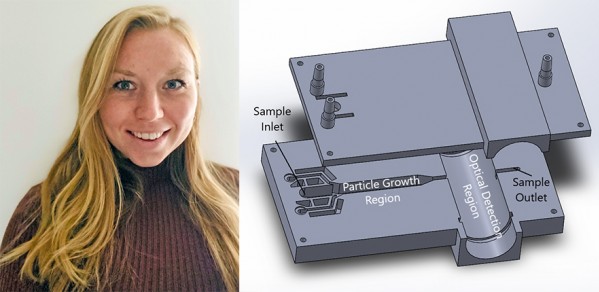
A research team behind a miniature device designed to detect airborne nanoparticles that have known health and environmental effects – such as viruses and pollutants – have won funding for its development.
We are hoping that our mini CPC will be used for citizen science, but also as an integral (hidden) part of new technology such as smart filtration systems or in-home particle monitoring.
Dr Molly Haugen
The mini condensation particle counter (CPC) works using water, heat and a common light source to provide a particle number per cubic centimetre. The portable device, which measures 9cm x 5cm (small enough to fit into the palm of your hand) and costs under £1,000 to manufacture, can be used for personal knowledge (citizen science) and in industrial and research applications.
CPCs measure nanoparticles in the air by condensing a fluid onto the particles to make them large enough to detect. The Cambridge research team’s new device however is smaller and cheaper than those currently available, with standard CPCs weighing in at about a kilogram each and costing in the region of £10,000 to manufacture, says Dr Molly Haugen from the Department of Engineering.
Dr Haugen, Senior Research Associate in Emissions Measurement, accepted prize money of £5,000 recently on behalf of the cross-disciplinary research team, after their mini CPC came second in the 2021 Trinity Bradfield Prize. The prize includes access to a bespoke mentoring programme at The Bradfield Centre, a technology hub based at the Cambridge Science Park.
Aside from being wearable, the mini CPC is lightweight enough to be attached to drones for example, and small enough that it can be used in remote locations. Additionally, because it is low cost to manufacture, this means that multiple sensors could be used to measure particle dispersion (e.g. continuous low-level release versus accidental release) and/or real-time emission monitoring.
“We are hoping that our mini CPC will be used for citizen science, but also as an integral (hidden) part of new technology such as smart filtration systems or in-home particle monitoring. One such use could involve integrating it into a bigger system on planes, trains and buses to ensure that air recirculation filters are replaced when needed or to detect leaks or cracks in seals for example,” said Dr Haugen. “The mini CPC could be particularly useful for health organisations that require a low-cost way to constantly monitor particle levels and also for scientists, as we can then use this data to gain a universal understanding of how particles evolve and travel in the air.”
Dr Haugen’s personal motivation for developing the mini CPC stems from her experience in fieldwork in which she has used a variety of handheld, “low-cost” instruments, but not all of these came in at the price or size range suitable for her research.
“Professor Adam Boies came to the team with an idea for a low-cost particle sensor with the plan to detect particles down to 10 nm and I knew that I could add my expertise to developing an easy-to-use device that would have scientific merit,” she said. “The project is also self-serving as I intend to use this device both in my own research which includes particle detection using drones to research and monitor maritime emissions (so we need a low-mass sensor to increase flight time) and in remote, long-term studies using low-cost sensors.”

